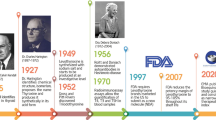Abstract
Levothyroxine sodium is a drug with a narrow therapeutic index for which an individual patient must have his or her dose carefully titrated to achieve the necessary therapeutic effect. In addition, exogenous levothyroxine cannot be distinguished from the endogenously produced hormone. Since 2004, generic formulations have been approved for the most frequently prescribed brands of levothyroxine sodium. This review examines the methodology and statistical acceptance criteria and summarizes findings of a previously published relative bioavailability study that brings into question the use of standard criteria to assess bioequivalence of levothyroxine sodium. The key findings reviewed were the following: (1) in the absence of baseline correction for endogenous T4 levels, products that differed by as much as 25% to 33% would be declared bioequivalent; (2) the use of baseline correction reduced the likelihood of declaring products bioequivalent when they actually differed by 25% to 33%; (3) even with baseline correction, products that differed by 12.5% would be declared bioequivalent; and (4) there was evidence of significant carryover from one dosing period to the next even with washout periods of up to 53 days. In conclusion, the current recommended methodology in the United States to assess bioequivalence for levothyroxine sodium products is inadequate to differentiate products that differ by 12.5%, a clinically relevant difference. Recommendations are made for modifications to the criteria that could improve the likelihood that products that differ by a clinically significant amount in their bioavailability would not be accepted as bioequivalent.
Similar content being viewed by others
References
Food and Drug Administration. Guidance for Industry: Levothyroxine sodium tablets—In vivo pharmacokinetic and bioavailability studies and in vitro dissolution testing. Available at: http://www.fda.gov/cder/guidance/3645fnl.htm. Accessed December 3, 2004.
Scanlon MF, Toft AD. Regulation of thyrotropin secretion. In: Braverman LE, Utiger RD, eds.Werner & Ingbar's The Thyroid: A Fundamental and Clinical Text. 8th ed. Philadelphia, PA: Lippincott Williams & Wilkins; 2000:234–253.
Levoxyl [package insert]. St Louis, MO: Jones Pharma Incorporated; 2001.
Synthroid [package insert]. North Chicago, IL: Abbott Laboratories; 2002.
Demers LM, Spencer CA. The National Academy of Clinical Biochemistry Laboratory Medicine Practice Guidelines. Laboratory support for the diagnosis and monitoring of thyroid disease. Available at: http://www.nacb.org/lmpg/thyroid_Impg_pub.stm. Accessed December 3, 2004.
AACE Task Force. American Association of Clinical Endocrinologists-Medical guidelines for clinical practice for the evaluation and treatment of hyperthyroidism and hypothyroidism.Endocrine Prac. 2002;8:457–469.
Blakesley V, Awni W, Locke C, Ludden T, Granneman GR. Braverman LE. Are bioequivalence studies of levothyroxine sodium formulations in euthyroid volunteers reliable?Thyroid. 2004;14:191–200.
Food and Drug Administration. Guidance for Industry: Statistical approaches to establishing bioequivalence. Available at: http://www. fda.gov/cder/guidance/3616fnl.htm. Accessed December 3, 2004.
Food and Drug Administration. Approved drug products with therapeutic equivalence evaluations (Orange Book). 24th ed. Available at: http://www.fda.gov/cder/ob/docs/preface/ectablec.htm. Accessed December 3, 2004.
Author information
Authors and Affiliations
Corresponding author
Additional information
Published: March 30, 2005.
This review contains adaptations from figures and tables that were previously published by this author.
Rights and permissions
About this article
Cite this article
Blakesley, V.A. Current methodology to assess bioequivalence of levothyroxine sodium products is inadequate. AAPS J 7, 5 (2005). https://doi.org/10.1208/aapsj070105
Received:
Accepted:
DOI: https://doi.org/10.1208/aapsj070105



